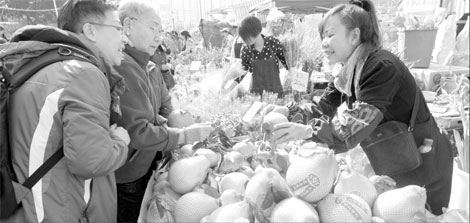StanChart warns of QE2 inflation danger
Updated: 2011-02-10 07:33
By Joy Li(HK Edition)
|
|||||||||
|
People purchase traditional fruits at the lunar new year flower market in Hong Kong. StanChart forecast that the city's CPI could reach 4 percent in 2011. Mike Clarke / AFP |
Standard Chartered Bank economists, who forecast an average 4 percent CPI in the city this year, warned of a further boost to inflation from the lagging effects of the second round of quantitative easing (QE2) in the US.
In the bank's latest global research report, Hong Kong is described as "off to a 'hot' start" in 2011, which means people should "brace for more talk of inflation".
Simon Wong, regional economist at Standard Chartered, forecast that the city's CPI in 2011 could hit an average of 4 percent, with the peak level likely to be in the middle of the year.
Standard Chartered is the latest major bank to issue a warning on the city's inflationary outlook. Earlier, Hang Seng bank said the headline CPI in Hong Kong could reach 5 percent in 2011, with the peak figure likely to be seen in the first six months. In an economic outlook report released in January, HSBC suggested that Hong Kong's inflation will average around 4 percent during the first quarter and then continue to climb until the end of 2011. The average inflation rate is estimated at 4.9 percent for the fourth quarter of 2011.
The city's consumer prices accelerated to a 23-month high by the end of 2010. Figures released by the government showed that the city's overall CPI rose 3.1 percent year-on-year in December.
A further break-down of CPI components revealed that food prices increased 4.3 percent in December while housing prices rose 2.5 percent compared with the same period in 2009. Both expanded faster than the readings of 3.8 percent and 2.1 percent in November.
Food price hikes have set off alarms around the world, especially among food-importing economies. FAO Food Price Index, a measure of the monthly change in the international price of a basket of food commodities, kicked off 2011 with a reading exceeding its previous peak in June 2008.
Though rising food prices have caught most of the limelight, excess liquidity is a bigger problem than food as a driver of inflation, Nicholas Kwan, head of research at Standard Chartered, pointed out on Wednesday.
In response to the global financial crisis, central banks worldwide took the medicine of pumping huge liquidity into the market to fend off shocks and boost domestic demand. Meanwhile, as the region enjoyed the fastest recovery, emerging markets in Asia appear attractive to "hot money" seeking higher returns.
In November of 2010, the US Federal Reserve announced a second round of quantitative easing, buying treasury bonds with $600 billion to lift the economy from its lackluster recovery.
Consequently, people in this part of the world are seriously concerned that the freshly printed money will stir up trouble, pushing up asset prices in the real estate sector and stock market. However, the QE2 money is yet to come, according to Kwan.
Kwan said there have been no net capital inflows into the city since May 2010, as evident from the zero change in the aggregate balance of the city's monetary base. He said this contrasts with the common belief that foreign money has been flooding the market and driving up asset prices.
Kwan said that "leverage is the key threat". Since Hong Kong has no independent monetary policies at hand, it is of vital importance for the government to tame its leverage ratio, so as to manage the risk of an asset bubble, he said.
China Daily
(HK Edition 02/10/2011 page3)
